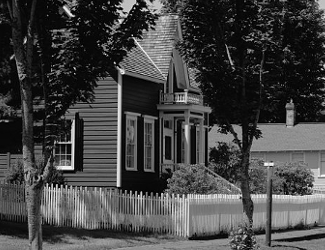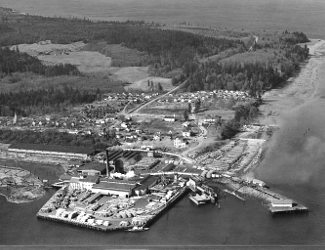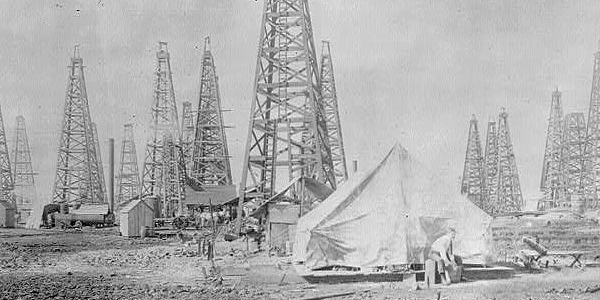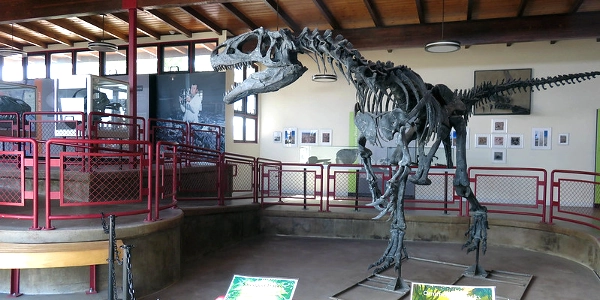
Image above: Port Gamble General Store, Historic American Buildings Survey. Courtesy Library of Congress.
Spotlight on Lesser Known History
Port Gamble, Washington
America's Best History Spotlight
On this page we're going to Spotlight the lesser known historic sites and attractions that dot the history landscape across the USA and are worth a visit if you're in their area. And while they may be lesser known, some are very unique, and will be that rare find. You'll be, at times, on the ground floor, or maybe even know something others don't. It'll be fun. Visit them.

Port Gamble, Washington
It was a lumber town. It was a successful lumber town. And today many think of Port Gamble as a New England style quaint village of shops and history. Of course, that's a bit disrespectful to its Washington State, Puget Sound, and northwest USA heritage, but, of course, it's meant as a complement and was built that way to please the men from New England who worked there. Travel to Port Gamble and you're likely to have a nice pleasant day wandering around quaint streets, cafes, and chocolate shops. There's a museum, and the water, and all the charm that the Pacific Northwest can so beautifully display. Photo above: Port Gamble and the Puget Lumber Company Mills, 1900, Seattle and the Orient, Alfred D. Bowen. Courtesy Wikipedia Commons.
Sponsor this page for $100 per year. Your banner or text ad can fill the space above.
Click here to Sponsor the page and how to reserve your ad.
Info, What's There Now, History Nearby

Port Gamble, Washington
So what's there now and how does it reflect back to its historic lumber past? For one, and it is House #1, the Walker-Ames House was built in 1888, and as you can see from the photos above and below, has stood the test of time well. A visit by day to the town immerses yourself in that history, but much of Port Gamble's charm pulls from a walk and glance into shops and cute places to eat. If you want to take in more of its pleasures, you can also stay overnight; the Port Gamble Guest Houses in town are a special treat. The Thorndyke Lodge nearby also suits many with its location on Hood Canal.
If you're lucky enough to be in town in early August, take in the Summer Faire, a festival of fun and music, and for those that like haunt stories, there are Ghost Walks amidst the town structures on special days of the year. Must be 16 and over to attend them.
Image above: Walker-Ames House, Historic American Buildings Survey. Courtesy Library of Congress. Below: Walker-Ames House, 2008. Courtesy Wikipedia Commons.

Where Is It
Port Gamble is not the easiest place to get to, predominantly because the water of Puget Sound becomes an obstacle from the normal public metros of Seattle and Tacoma. It's only twenty-one miles from Seattle, but a car trip is 87.5 miles, unless you desire to take the Kingston Ferry (fee). Both trips will take you about a bit over an hour and one half. If you aren't committed to your car, a ferry (Kitsap Fast Ferry) and taxi ride takes less than one hour, but will cost you $28-52.
Buy Chronology

Great Book for the History Fan with Fifty Short Essays Telling the Story of American History.
What is There Now
Restored lumber village that's registered as a National Historic Landmark. One hundred and twenty acres of quaint village shops, views of Puget Sound, and a respite from the normal hectic work days. Examples include the Port Gamble General Store and Cafe, the Port Gamble Historic Museum, the Olympic Outdoor Center, and the Painted Lady antique shop.
There's also summer theater at the Port Gamble Theater Company, established originally in 1906. Hiking trails and biking trails abound as well.
When Open and How Much
Port Gamble is a town, not a single historic site or park. Hours vary depending on the establishment. The Port Gamble Historic Museum charges $4 for adults, $3 students, free 6 and under, as an example.
Fees subject to change.
Websites
Port Gamble
Visit Kitsap
History Nearby
The national parks of Washington State are in the area, of course, including Olympic National Park, Mount Rainier National Park, and the San Juan Islands twosome around nature and a Pig War. Suffice it to say, there's plenty to see. Smaller history sites include the Newberry Hill Heritage Park, a wildlife refuge, Tracyton, another logging town, and Blake Island State Park and Tillicum Village.
Photos, History, and More Spotlights

History of the Town
Much of its past surrounds the operation of the sawmill, that saw inception in 1853 and operation until 1995. Yes, 1995. That inception was the vision of William Pope and Andrew Talbot, who had arrived in 1849 from East Machias, Maine, and with the thousand settlers and convinced easternors now resettled along Puget Sound who worked in the lumber industry, they operated the sawmill for over one hundred and forty years, the longest continuous operation of a sawmill at the time.
So why does it bring in the thought of New England with a splash of midwest flair? That's what the buildings were constructed to represent as Pope and Talbot hailed from the east. Today, the town is maintained to retain that charm by a private company. Yes, it's still a company town.
Image above: Thompson House, built in 1859, in the residential district of Port Gamble, Historic American Buildings Survey. Courtesy Library of Congress.

Places to Visit
Perhaps not the first stop after you settle in, but should be on the agenda somewhere, is the Port Gamble Historic Museum, situated inside one of the millsite offices. There you'll get a sense of where you are, or how you would have lived during the mill's operation. Probably pretty loud; big difference to today's quiet. Open late May to early September.
During the day, there's plenty of places to shop or recreate. For the shopping kind, the Port Gamble General Store and Cafe is a must, but not far behind, take in the Painted Lady, the Artful Ewe, Quilted Strait, or for a beverage and more, the House 11 Taproom, Scratch Kitchen, and others.
Recreation, day style, includes kayak and canoe rentals from the Olympic Outdoors Center, hikes on trails within the 4,300 acre town owned forest, or take in, or participate, if able, in a bike race on gravel trails through the forest.
At night, take in a play at the Port Gamble Theater, which usually runs its season from late March into December.
Photo above: Port Gamble commercial district, Historic American Buildings Survey. Courtesy Library of Congress.

History of the Area
The area around Puget Sound, and specifically Gamble Bay, was founded during the Wilkes Expedition of 1841. It's not really known why the name was given, although some passages from Wilkes note that the men were gambling with the Suquamish indians for blankets during the expedition. As good a tale as any, whether accurate or not. The town took the name of Port Gamble in 1868, after the founding of the mill in 1853.
Pope and Talbot founded the Puget Mill Company with two partners, Joseph Keller and Charles Foster, and recruited workers from their home state of Maine. The construction in the New England style was done, in some ways, to make the men feel more at home. By 1862, the company owned ten ships and was shipping 19 million board feet of lumber all over the world.
Photo Above: Aerial view of Port Gamble, 1953, Pope and Talbot Archives. Courtesy Library of Congress.

T-Shirts and Gifts from the official souvenirs of Americasbesthistory.com.
About
America's Best History where we take a look at the timeline of American History and the historic sites and national parks that hold that history within their lands.
Photos courtesy of the Library of Congress, National Archives, National Park Service, americasbesthistory.com and its licensors.


